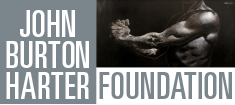The John Burton Harter Foundation proudly presents “Homoeroticism in Gay Male Art: Then and Now,” a panel discussion examining the art of Patrick Angus (1953-1992) and John Burton Harter (1940-2002) and the recent work of Los Angeles artists Rubén Esparza and Ken Gun Min.
The panel will take place on Saturday, November 16, 2024, at 3:30 p.m. at Gabba Gallery, 235 S. Broadway, Los Angeles. A reception will follow.
The panel is inspired by the publication A Tale of Two Cities: Patrick Angus in New York and J. B. Harter in New Orleans. Attendees will receive a complimentary copy, featuring an essay by curator and art critic David S. Rubin. Rubin will also moderate the discussion.
Panelists will discuss the works of Angus and Harter, both of whom led the use of gay male erotic imagery in paintings of the late 20th century, but who never received commercial or critical success during their lifetimes. Esparza and Min will also focus on homoerotic themes and imagery in their own artwork.
“Placing Angus and Harter side-by-side helps show that even in the throes of the AIDS epidemic, the gay community remained a vibrant place where people lived and loved,” said Jack Sullivan, John Burton Harter Foundation Advisor.
Gabba Gallery is located near the new Historic Broadway stop on the E Line of the L.A. Metro. Parking is available in a lot by the gallery.
For more information, please email jbharterfoundation@gmail.com.
Angus and Harter: A Realist and an Idealist
Although more than ten years apart in age, Patrick Angus and John Burton Harter realized they were gay in the late 1960s, just as the sexual revolution was accelerating. Whereas Angus remained fairly open about his sexual orientation, Harter stayed closeted until the early 1990s, after both of his parents were deceased.
In the 1980s, Angus created a significant body of paintings documenting the performances, cruising, and hustling that took place at the Gaiety Theater. This male strip club in New York City was frequented mostly by gay men who socialized with the models in lounge areas and cruised in the theater while pornographic movies were shown.
Working in a style influenced by the paintings of David Hockney and the Bay Area Figurative School, Angus showed life at the Gaiety using gestural brushwork in a manner replicating the immediacy of the early 20th-century Ash Can School. He also viewed his subject matter from vantage points that put the viewer in the audience. Because photography was not permitted at the Gaiety, Angus worked primarily from memory. The late playwright Robert Patrick referred to him as “The Toulouse-Lautrec of Times Square.”
Although there were no male strip clubs in New Orleans, where Harter lived and worked as a museum curator, he nevertheless drew inspiration for his paintings and drawings of the 1990s from a gay culture that included a bathhouse (also a subject for Angus), private sex parties, and outdoor cruising. Harter’s paintings are based on photographs he took of his models, most of whom were young men that he met at the gym or on the street.
Whereas Angus was a realist, in the sense that he sought to recreate what it felt like to be at the Gaiety, Harter was an idealist who preferred the classical style of antiquity and the Renaissance, which had influenced the homoerotic paintings of Paul Cadmus in the 1930s.
About the Panelists
David S. Rubin is a Los Angeles-based curator, writer, and artist. He has held curatorial positions at the Museum of Contemporary Art, Cleveland; Phoenix Art Museum; Contemporary Arts Center, New Orleans; and San Antonio Museum of Art, among other institutions. He is known for thematic exhibitions on contemporary themes and topics, such as “Old Glory: The American Flag in Contemporary Art” and “It’s Only Rock and Roll: Rock and Roll Currents in Contemporary Art.” In 1996, he served as U.S. Commissioner for the Cuenca Bienal of Painting in Ecuador. Rubin is currently a contributor to Hyperallergic, Visual Art Source, and Artillery and has published numerous books and exhibition catalogs. His drawings are in the permanent collections of the Ogden Museum of Southern Art, New Orleans, and the Bradbury Art Museum at Arkansas State University. For more information, please visit www.davidsrubin.com.
Rubén Esparza is a Los Angeles-based artist and independent curator whose wide-ranging practice encompasses painting, photography, and drawing realized in analog and digital forms. Esparza’s art practice explores Queer and Latinx histories, existential trauma, and the reconciliation of his heritage, that of the colonizer and the colonized within and in conversation with the Western/Mexica art canon. Esparza is the Founder and Director of Queer Biennial, an international survey of LGBTQ+ art and queer diasporas, and Queer Califas, which exhibits queer Latinx artists. His art is in the collections of the Los Angeles County Museum of Art and the Museum of Contemporary Art, San Diego, among others. For more information, please visit www.rubenesparza.com.
Ken Gun Min is a Los Angeles-based painter whose paintings explore intimacy, masculinity, and representation across cultures, employing a mix of Western-style oil paints, Asian pigments, embroidery, and beading on raw canvas. Often featuring nude and queer-coded men, his portraits and lush, vibrant landscapes concoct fanciful queer idylls where longing, melancholy, and euphoria manifest regardless of expectations imposed by daily life. Born in Seoul, Min lived in San Francisco, Zurich, and Berlin before settling in Los Angeles. His art is in the collections of the Los Angeles County Museum of Art; the Institute of Contemporary Art, Miami; the Speed Art Museum, Louisville; the X Museum, Beijing; and the Hessel Museum of Art at Bard College. For more information, please visit www.kengunmin.com.
Event Details
Date: Saturday, November 16, 2024
Time: 3:30 – 5:30 p.m.
Location: Gabba Gallery, 235 S. Broadway, Los Angeles, CA 90012
Free
Images Below
Paintings
- J. B. Harter, Sea Wall 1, 1993, oil on board, 40 x 40 in., The John Burton Harter Foundation.
- Ken Gun Min, Ambiguous Yoga Club, 2023, oil, Korean pigment, silk embroidery thread, beads, and crystals on canvas, 92 x 70 in., courtesy of the artist.
- Patrick Angus, The Grand Finale, 1986, acrylic on canvas, 48 x 54 in., Collection of David Hockney.
- Rubén Esparza, Security Suck, 1997, acrylic on 100% cotton paper, 14 x 12 in., published in Honcho Magazine, @Rubén Esparza.
Photos
- David Rubin
- Ken Gun Min
- Rubén Esparza

